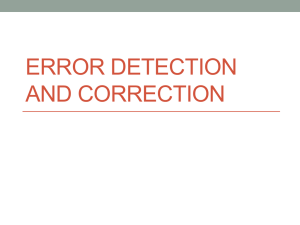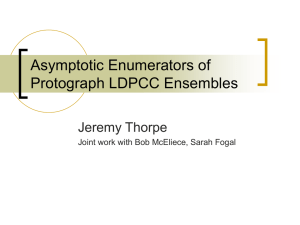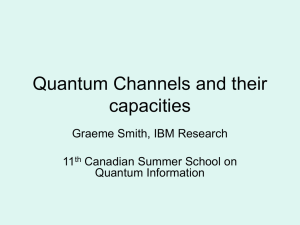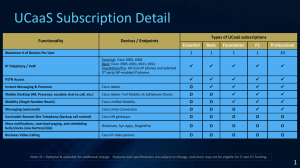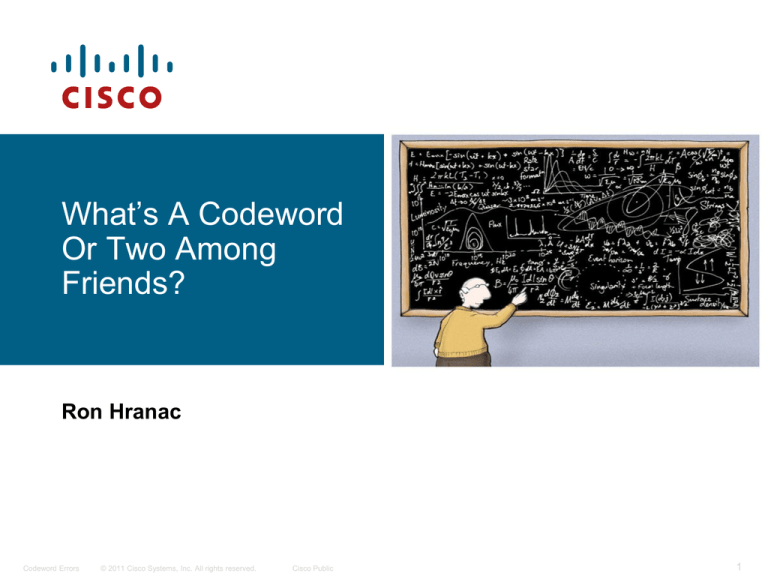
What’s A Codeword
Or Two Among
Friends?
Ron Hranac
Codeword Errors
© 2011 Cisco Systems, Inc. All rights reserved.
Cisco Public
1
The World of Codewords
Questions often crop up about codewords, codeword
errors, and acceptable percentages of DOCSIS upstream
codeword errors. What the heck is this codeword stuff
anyway?
A good place to start is to first define
what a codeword is, and how it applies
to the world of data transmission over
cable networks. We’ll get to that shortly.
All of this falls under the umbrella of something known as
forward error correction (FEC), a combination of
techniques and algorithms used to identify and fix data
transmission errors.
Codeword Errors
© 2011 Cisco Systems, Inc. All rights reserved.
Cisco Public
2
Ensuring Data Transmission Integrity
In an ideal world, all bits would be received exactly as
transmitted
Bit errors can and do occur, but there are ways to
detect—and sometimes correct—those errors
The simplest form of error detection is parity checking
Appending a row of bits with a parity bit allows for simple error
checking, but it doesn’t tell where in that row of bits the error
occurred
Applying parity in two dimensions—that is, in rows and
columns—not only tells us that an error occurred, but also
where it occurred! This is known as block coding.
Examples of coding in DOCSIS include Reed Solomon (RS) and
Trellis coding
Codeword Errors
© 2011 Cisco Systems, Inc. All rights reserved.
Cisco Public
3
Parity
One method of identifying errors is parity detection
For example, a parity bit can be appended to a group of
seven bits
Assume that even parity is used. The appended bit will be a
1 if an odd number of 1s is in the original seven bits, and a 0
if there is an even number of 1s
Parity allows the detection of an odd number of errors,
but doesn’t tell us which bit (or bits) is in error
7-bit word
Parity bit
0110100 1
Transmitted word
(including parity bit)
Error occurs
01101001
01001001
© 2011 Cisco Systems, Inc. All rights reserved.
0100100 1
Receiver cannot determine
which bit is in error, only
that an error occurred.
Total number of 1s is now even,
hence the name “even parity”
Codeword Errors
Receiver detects error
because parity bit is
wrong for number of 1s
now in 7-bit word
Cisco Public
4
Block Coding
As mentioned previously, applying parity in two
dimensions—that is, in rows and columns—not only
tells us that an error occurred, but also where it
occurred! This is known as block coding.
Original data stream
0110100111000100110011100110
Groups of 7-bit words
shown for clarity
0110100 1110001 0011001 1100110
Data arranged into a
tabular form, and parity
bits appended to rows
and columns
0110100
1110001
0011001
1100110
1
0
1
0
Parity bits
0111010 0
0110100111100010001100111100110001110100
Codeword Errors
© 2011 Cisco Systems, Inc. All rights reserved.
Cisco Public
Transmitted data
stream with parity
bits added
5
Block Coding
Transmitted data
stream with parity
bits and a bit error.
The 0 shown in red
was originally a 1.
0110100111100010001000111100110001110100
0110100
1110001
0010001
1100110
Data arranged into a tabular
form in the receiver, and
parity bits in rows and
columns are checked.
1
0
1
0
0111010 0
Parity errors!
Received data stream
with parity bits removed
and errored bit
corrected.
0110100111000100110011100110
Adapted from example in Modern Cable Television Technology, 2nd Ed.
Codeword Errors
© 2011 Cisco Systems, Inc. All rights reserved.
Cisco Public
6
Ensuring Data Transmission Integrity
ITU-T Recommendation J.83, Annex B, defines
downstream data transmission in cable networks:
We’re interested in the FEC part of this
Source: ITU-T Recommendation J.83
Codeword Errors
© 2011 Cisco Systems, Inc. All rights reserved.
Cisco Public
7
Ensuring Data Transmission Integrity
In J.83, FEC has four processing layers comprising
Reed Solomon coding, interleaving, randomization, and
Trellis coding
Source: ITU-T Recommendation J.83
Codeword Errors
© 2011 Cisco Systems, Inc. All rights reserved.
Cisco Public
8
DOCSIS Downstream Codewords
As data enters a RS encoder, it is grouped into chunks
called blocks or codewords, or more specifically, RS
blocks or RS codewords (I’ll use the latter terminology
throughout the remainder of this discussion).
Each downstream RS codeword is made up of 128 RS
symbols, and each RS symbol is 7 bits.
Note that RS “symbols” are not the same kind of symbols that
make up each symbol point in a QAM constellation.
0
1
1
0
0
1
≠
0
7 bits = 1 RS symbol
Codeword Errors
© 2011 Cisco Systems, Inc. All rights reserved.
Cisco Public
9
DOCSIS Downstream Codewords
122 of each RS codeword’s 128 symbols are data
symbols, and the remaining six are parity symbols used
for error correction.
ITU-T J.83, Annex B states that the data is “…encoded using a
(128,122) code over GF(128)…” which shows each RS
codeword consists of 128 RS symbols (first number in first
parentheses) and the number of data symbols per RS
codeword is 122 (second number in first parentheses), leaving
six symbols per RS codeword for error correction.
DOCSIS downstream RS FEC is configured for what is
known as “t = 3,” which means that the FEC can fix up
to any three errored RS symbols in a RS codeword.
Codeword Errors
© 2011 Cisco Systems, Inc. All rights reserved.
Cisco Public
10
DOCSIS Downstream Codewords
In DOCSIS downstream Reed Solomon FEC, 7 bits =
1 RS symbol, and 128 RS symbols = 1 RS codeword
0
1
1
0
0
1
0
7 bits = 1 RS symbol
RS symbol #1
RS symbol #2
RS symbol #3
RS symbol #4
RS symbol #127
RS symbol #128
128 RS symbols = 1 RS codeword
In each RS codeword: 122 RS symbols = data symbols, 6 RS symbols = parity symbols
Codeword Errors
© 2011 Cisco Systems, Inc. All rights reserved.
Cisco Public
11
Codeword Errors
What happens when there is, say, a burst of noise that
causes a bit error or errors in one RS symbol?
It doesn’t matter to the RS decoder if one bit in that RS
symbol is errored or all seven bits are errored—the
entire symbol is considered broken.
= good RS symbol
= errored RS symbol
= errored RS symbol
= errored RS symbol
Codeword Errors
© 2011 Cisco Systems, Inc. All rights reserved.
Cisco Public
12
Codeword Errors
With a RS FEC configuration of “t = 3” the FEC decoder
can fix up to any 3 errored symbols in a RS codeword
128 RS symbols = 1 RS codeword
This is a correctable codeword error
When there are more than 3 errored symbols in a
codeword the entire codeword is errored
This is an uncorrectable codeword error
Codeword Errors
© 2011 Cisco Systems, Inc. All rights reserved.
Cisco Public
13
DOCSIS Downstream Codewords
There can be anywhere from three to
21 bit errors in a RS codeword that
has three errored RS symbols.
For a t = 3 configuration, as long as
there are no more than three errored
RS symbols in a given codeword, the
FEC decoder in the cable modem can
fix all of them. That would result in
what’s known as a correctable FEC
error or correctable codeword error.
Codeword Errors
© 2011 Cisco Systems, Inc. All rights reserved.
Cisco Public
14
DOCSIS Downstream Codewords
As soon as the number of errored RS symbols in a
given RS codeword is four or more, the entire RS
codeword is toast.
FEC can’t fix three RS symbols and leave the remaining ones
broken; if more than three RS symbols are errored, the entire
RS codeword is errored.
That errored codeword is now an
uncorrectable codeword, and we
have an uncorrectable FEC error
or uncorrectable codeword error!
Codeword Errors
© 2011 Cisco Systems, Inc. All rights reserved.
Cisco Public
15
DOCSIS Upstream Codewords
DOCSIS downstream FEC is fairly straightforward, at
least from the perspective of a fixed RS codeword size
(128 RS symbols) and t = 3 configuration.
When DOCSIS 1.0 was introduced, upstream FEC
supported codeword sizes ranging from 18 bytes (16
data or “k” bytes plus two parity bytes) up to 255 bytes
(k bytes + parity bytes), and t = 0 to t = 10.
DOCSIS 2.0 brought improved FEC, supporting t = 0 up
to t = 16.
Codeword Errors
© 2011 Cisco Systems, Inc. All rights reserved.
Cisco Public
16
DOCSIS Upstream Codewords
The same basic principles apply in the upstream as is
the case in the downstream: RS FEC can fix up to “t”
errored symbols (bytes) per RS codeword, but if the
number of errored symbols per codeword exceeds “t”,
the entire codeword is considered uncorrectable.
Codeword Errors
© 2011 Cisco Systems, Inc. All rights reserved.
Cisco Public
17
What’s Acceptable?
Which brings me to a common question: What’s an acceptable
percentage or number of upstream codeword errors?
That’s definitely an it depends question, but let’s start with an ideal
goal: No correctable or uncorrectable codeword errors at all in
either the downstream or upstream!
One could argue that in a network performing so well that there are
no codeword errors of any kind in the QAM signals, it would be
possible to take advantage of eliminating FEC overhead altogether
and picking up a little more throughput per channel.
Of course, this goal is unrealistic. There is no perfect cable
network that is completely free of data transmission errors. Still,
the fewer codeword errors, the better.
Codeword Errors
© 2011 Cisco Systems, Inc. All rights reserved.
Cisco Public
18
Upstream Packet Loss
Let’s look at another metric for a moment.
I have for several years suggested that upstream packet loss—
that is, packet loss in just the outside plant’s upstream
transmission path—be limited to no more than about 1 percent
when the traffic is plain old high-speed data.
If voice is thrown into the mix, upstream packet loss should not
exceed about 0.1 to 0.5 percent, with the lower end of that
range the better place to be.
Codeword Errors
© 2011 Cisco Systems, Inc. All rights reserved.
Cisco Public
19
Codeword Errors vs. Packet Loss
How does upstream packet loss relate to codeword
errors? That’s another it depends.
First, if uncorrectable codeword errors exist, that means
that packet loss is happening. However, uncorrectable
codeword errors do not necessarily track lost packets
on a one-for-one basis.
For instance, one can configure upstream operation such that
packet length equals the number of information bytes in a
codeword.
One also could have a configuration in which the packet length
is longer than the number of information bytes in one codeword,
but less than in two codewords.
Codeword Errors
© 2011 Cisco Systems, Inc. All rights reserved.
Cisco Public
20
Codeword Errors vs. Packet Loss
It might be worthwhile to work with your network
operations center folks to come up with a packet loss
estimate versus uncorrectable codeword errors in
relation to the specific configuration used in your
system.
From there, target maximum packet loss
goals similar to my previously suggested
numbers.
Once that’s done, start looking at trends
over time.
Codeword Errors
© 2011 Cisco Systems, Inc. All rights reserved.
Cisco Public
21
Packet Loss and Trends
Let’s say you find upstream packet loss to be less than 0.1
percent fairly consistently, but then you notice that it starts to
trend upwards to 0.1 percent, 0.2 percent, 0.25 percent, and
so on over some period of time.
That upward movement in packet loss suggests
that something is degrading upstream
performance and it’s getting worse.
Here the trend itself is arguably more
important than the actual packet loss value,
assuming the original value was reasonable
to begin with.
Codeword Errors
© 2011 Cisco Systems, Inc. All rights reserved.
Cisco Public
22
Other Troubleshooting Ideas
From a practical perspective, tracking uncorrectable
codeword errors should be considered one of many tools
used to troubleshoot problems. Others include modulation
error ratio (MER), a CMTS’s Flap List metrics, and perhaps
a third party spectrum monitoring tool.
Here are a couple examples of how evaluating more than
one metric can better help the troubleshooting process.
Let’s say the CMTS’s reported upstream MER (also called “upstream
SNR”) is good, but uncorrectable codeword errors are out of whack.
That may indicate impulse noise or laser clipping.
Low MER and excessive uncorrectable codeword errors could indicate
low carrier-to-noise ratio, or maybe the presence of some significant
linear distortions (micro-reflections, amplitude ripple, group delay).
Codeword Errors
© 2011 Cisco Systems, Inc. All rights reserved.
Cisco Public
23
Tracking Trends
One can certainly track raw correctable and
uncorrectable codeword error numbers—and many
cable operators do—but another metric is to track
codeword error ratio (CER)
The following example is excerpted from one
of my Communications Technology magazine
columns written back in 2003:
According to Motorola’s Marc Belland, using upstream uncorrectable
codewords is one of the best ways to complement the CMTS’s [MER] estimate.
Says Belland, “I know of several operators who use the following three
management information base (MIB) values to calculate, using a script, what
can be called codeword error ratio (CER) on their CMTS upstream ports. They
are:
docsIfSigQUnerroreds
docsIfSigQCorrecteds
docsIfSigQUncorrectables
Codeword Errors
© 2011 Cisco Systems, Inc. All rights reserved.
Cisco Public
24
Tracking Trends (cont’d)
“A total of all three divided into the uncorrectables number will give you a CER
at that point in time. Subsequent polls at user specified intervals—for example,
every five minutes—can give you a trend as to whether the upstream is getting
better or worse. Obviously if it’s getting worse you’ll need to pro-actively get
someone to attend to the issue, depending on the rate of upstream
degradation.”
Belland provided the following example, which could be ported to an Excel
spreadsheet:
unerroreds: 1,562,456
correctables: 803,867
uncorrectables: 209,134
total: 2,575,457
loss %: 8.120%
CER = 8.12E-02
Codeword Errors
© 2011 Cisco Systems, Inc. All rights reserved.
Cisco Public
25
Additional Resources
You’ll find some other useful background information
and ideas in an older white paper authored by Cisco’s
John Downey:
“Upstream FEC Errors and SNR as Ways to Ensure Data
Quality and Throughput,” available at
http://www.cisco.com/en/US/tech/tk86/tk319/technologies_white
_paper09186a0080231a71.shtml
An updated version of the paper is available but not
online. Contact John directly at jdowney@cisco.com to
get a copy of the newer version.
Codeword Errors
© 2011 Cisco Systems, Inc. All rights reserved.
Cisco Public
26
Q and A
Codeword Errors
© 2011 Cisco Systems, Inc. All rights reserved.
Cisco Public
27


